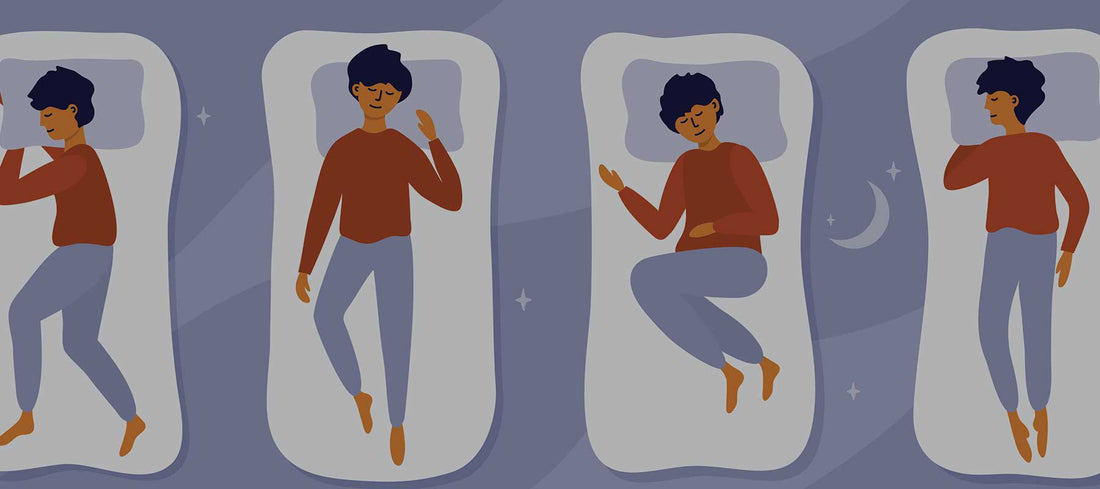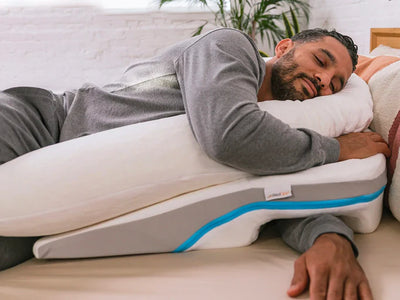
Related Product

Shoulder Relief System
$249.99 USD
Our system has a patented arm pocket that allows your arm to rest comfortably, alleviating pressure on your shoulder and triggering pain.
Most Comfortable Sleeping Positions
Share
There is no place quite like your bed after a long, stressful day. You spent the entire day dreaming about that moment when your head hits your pillow, the feeling of melting into your cozy sheets. The second you climb into your bed you fall asleep, your mind wandering off to blissful dreams. In the morning, you wake up feeling refreshed and you jump out of bed, ready to take on whatever the day ahead of you has in store.
You may be wondering: why is sleep so important? Getting a good night’s rest is important for a myriad of reasons. It helps you stay focused throughout the day, boosts your mood, and improves productivity. There is a reason why you wake up feeling groggy and annoyed after a bad night’s rest- your body needs sleep to properly function! But falling asleep as soon as your head hits the pillow isn’t always possible. Often we’re stuck laying in bed for hours, staring at the ceiling and counting how many times the fan turns.
Not being able to fall asleep can happen because of many reasons, including not being able to get into a comfortable sleeping position. Comfortable sleeping positions are the key to a good night’s rest. Once you find one, stick to it! There’s nothing better than knowing exactly the right position you need to fall asleep. If you have been struggling falling asleep at night, you might want to take a look at the positions you sleep in.
Here, we’ll discuss the various types of comfortable sleeping positions to choose from so you can find the one that works best for you.
- Types Of Sleeping Positions
- Pick The Most Comfortable Position For You
- How To Improve Your Sleep
- Wrapping Up
Types Of Sleeping Positions
There are three main types of sleeping positions, back-sleeping, side-sleeping, and stomach-sleeping, each with unique benefits and drawbacks to your health and comfortability. Let’s take a look.
Back-sleeping
Back-sleeping is when an individual lies flat on their back in bed and it is often referred to as the supine position. Sleeping on your back can be beneficial as it evenly distributes weight across the widest part of your body, but that does not mean it’s right for everyone. Back-sleeping improves spinal alignment, reduces joint pressure, and ensures alignment of your internal organs. It can also alleviate neck pain since your neck, back, and spine are kept in a neutral position.

But before you jump into bed thinking that back-sleeping is the most comfortable sleeping position for you, let’s look at its disadvantages. Sleeping on your back can cause or worsen lower back pain. It is also not the best sleeping position if you snore, have sleep apnea, or are pregnant. It is a good idea to take these into consideration before you decide that back-sleeping is right for you.
Side-sleeping
Side-sleeping is when an individual lies on either their left or right side of their body in bed. Side-sleeping with an arm overhead is the most common sleeping position, representing 55% of your time asleep in bed. Sleeping on your side is good if you snore as it minimizes the frequency of sleep apnea breathing irregularities.

However, while this may be the default sleeping position for many, that does not mean it is the best for your body. Sticking to one side of your body can cause muscle imbalance and pain, which is why it is crucial to alternate sides throughout the night. Alternating sides can prevent organ strain and overall help you achieve a more comfortable night’s rest. Side-sleeping is one of the most comfortable sleeping positions for many people, so if you find yourself defaulting to this, just make sure you switch sides as you sleep.
Stomach-sleeping
Stomach-sleeping is when an individual lies flat on their stomach in bed. Only a small percentage of people prefer this position, as many find it uncomfortable. Sleeping on your stomach with your head turned to one side can cause neck pain, poor spinal alignment, and constricted blood circulation.

There aren’t many advantages to stomach-sleeping, so if this is your preferred position, it might be time to change things up. It is best to try to avoid stomach-sleeping all together, but if you find that you absolutely can’t, just make sure you sleep with a pillow on your forehead so your spine and head are kept in a neutral position.
Pick The Most Comfortable Position For You
So, now that you know about the three most common types of sleeping positions, you’re probably thinking: what position should I sleep in? There are pros and cons to each one, so in order to find your best sleeping position, you have to take a look at your health priorities.
- If you suffer from snoring or sleep apnea, side-sleeping is likely going to be the most comfortable position for you. Sleeping on your side reduces the frequency and intensity of snoring and encourages blood flow.
- If you have back or shoulder pain, try back-sleeping. Sleeping on your back takes pressure off of your shoulders and evenly distributes weight across your spine.
- If you experience nighttime acid reflux, you should try side-sleeping on your left with your torso elevated. This positioning of your body can help to reduce heartburn while you sleep and make you feel more comfy in bed.
- If your priority is to avoid wrinkles on your chest and face while you sleep, back-sleeping is probably your best sleeping position. Sleeping on your back prevents wrinkles because of the lack of wrinkle-inducing friction and pressure of your face going into your pillow.
- If you are pregnant, you should sleep on your side to encourage blood flow to the fetus.
Finding a comfortable sleeping position can be difficult. It may take some trial and error before you find a position that works for you. It is important to look at your own situation and priorities in order to determine your best sleeping position. But once you figure it out, you will get the best sleep of your life, every night.

How To Improve Your Sleep
There is nothing worse than climbing into bed after a long day and not being able to fall asleep. Sometimes even figuring out your most comfortable sleeping positions isn’t enough. Getting a good night’s rest can be a lot harder to achieve than you may think. If you’re having trouble staying asleep or falling asleep to begin with, you may need to take some time to improve your environment:
1. Have comfy sheets and pillows
We all know the feeling of waking up in the morning, completely covered in buttery soft sheets and just not wanting to get up. Having comfy sheets and pillows is key to getting good sleep. For your sheets, aim for a thread count between 200 and 400, which will be breathable and soft. Depending on how hot you get at night impacts the material you should choose. If you know you sweat a lot throughout the night, go for a more breathable material, like cotton or bamboo.
2. Make your bed comfortable
Nothing beats feeling comfy in bed. A comfortable mattress and soft sheets and pillows are all essential to achieve that, but you may need to take it a step further to really improve your sleep. Using a therapeutic body pillow is one way you can achieve that good night’s rest. A therapeutic body pillow is great for those with sciatica, lower back pain, and neck pain as it provides full body support as you sleep.
If chronic shoulder pain is what is stopping you from getting good sleep, you may want to consider using a shoulder relief system. This can help to relieve shoulder pain by supporting your entire body and easing the pressure that is normally put on your shoulder while you sleep.
If you experience nighttime heartburn, you should check out an acid reflux relief system. This has been clinically-proven to reduce painful heartburn that may be hindering you from falling asleep. It provides natural heartburn relief without medication and protects you from harmful acid.
3. Make sure the room is dark
If you’re struggling with falling asleep or staying asleep throughout the night, it might just be because your room is too bright. Having a dark bedroom is essential in getting a good night’s rest. There are a couple of ways you can achieve this:
- Make sure you have curtains or blinds that sufficiently block light
- Wear an eye mask to bed
- Reduce your exposure to bright light before bed—that means not going on your phone up to 30 minutes before you sleep and eliminating any sources of bright light from your bedroom.
Wrapping Up
Getting good sleep is crucial for your physical health, mental health, and overall well-being. But not being able to fall asleep or stay asleep is extremely frustrating. Figuring out your most comfortable sleeping position and taking certain measures to improve your sleep will make a world of a difference in your life. We all deserve to wake up every morning feeling refreshed and ready to take on the day ahead, so make sure you take the proper steps to achieve that.
Related Product

Shoulder Relief System
$249.99 USD
Our system has a patented arm pocket that allows your arm to rest comfortably, alleviating pressure on your shoulder and triggering pain.


